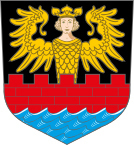Categories Online-Shop Germany Medals Emden
Emden

The exact founding date of Emden is unknown, but it has existed at least since the 8th century. Older names for Emden are Amuthon, Embda, Emda, and Embden. Town privilege and the town's coat of arms, the Engelke up de Muer (The Little Angel on the Wall) was granted by Emperor Maximilian I in 1495.
In the 16th century, Emden briefly became an important centre for the Protestant Reformation under the rule of Countess Anna von Oldenburg who was determined to find a religious "third way" between Lutheranism and Catholicism. In 1542 she invited the Polish noble John Laski (or Joahannes a Lasco) to become pastor of a Protestant church at Emden; and for 7 years he continued to spread the new religion around the area of East Frisia. However in 1549 following pressure from the Emperor Charles V, the Countess was forced to ask Laski to leave for England and the experiment came to an end. Nevertheless, the legacy was important for the reformation in the Netherlands.
Emden was a very rich town during the 17th century, due to large numbers of Dutch immigrants such as Diederik Jansz. Graeff. It was a centre of reformed Protestantism at that time, producing the first Bible translation in Dutch.
In 1744 Emden was annexed by Prussia. In 1752 Frederick the Great chartered the Emden Company to trade with Canton, but the company was ruined when Emden was captured by French forces in 1757 during the Seven Years' War. The town was recaptured by Anglo-German forces in 1758 and for the rest of the conflict was used as a major supply base by the British to support the ongoing war in Westphalia.
During the Napoleonic French era, Emden and the surrounding lands of East Frisia were part of the short-lived Kingdom of Holland.


